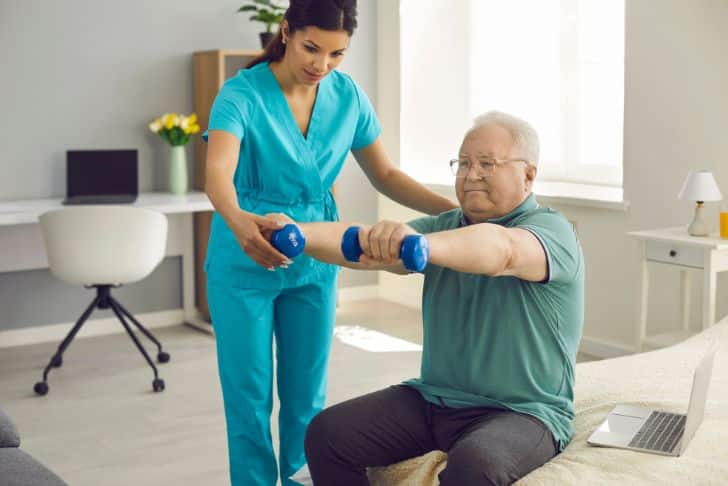In the article “Minimizing Fall Risks with Balance and Strength Exercises for Elderly,” the focus is on reducing the risk and occurrence of falls in older adults — a significant issue as more than a quarter of adults aged 65 and older experience a fall each year. Highlighting the role of a combination of factors like balance issues, multi-medication use, home hazards, and feet or footwear problems in elevating fall risks, the article discusses the importance of targeted exercise routines. Emphasizing balance and strength exercises such as the sit-to-stand exercise and different balance exercises, it underlines how these simple workout techniques can empower elderly individuals and provide them with stability and strength to prevent future falls. However, it does stress that these exercises are intended for those with a low risk of fall and who can stand without support from others, advising to consult with a doctor or physical therapist before starting a new exercise routine.

Understanding Fall Risks in the Elderly
Every year, more than a quarter of adults aged 65 or older experience a fall, and three million end up in emergency departments due to fall-related injuries. A fall can potentially have severe consequences, particularly as we age, so it’s crucial to understand the factors that increase the risk of falling and the repercussions of frequent falls.
Key Factors Inciting Falls in Older Adults
Several elements can compound the risk of falling in older adults. These factors can range from balance and gait-related problems, which are often issues due to changes in vision, vestibular problems, and changes in foot sensation. Additionally, certain medications you might be taking can enhance the likelihood of a fall, especially if you’re on five or more medicines. It’s essential to be aware of these factors and take necessary precautions to mitigate fall risks.
Implications of Frequent Falls
Falls can turn out to be pretty dangerous for the elderly. It’s not just about the physical harm, but also the fear of falling again that can make them increasingly less mobile and thus negatively affect their independence and quality of life. Additionally, frequent falls might indicate other underlying health conditions that need attention.
Consequences of Untreated Fall Risks
Unchecked fall risks can lead to dangerous fall injuries like hip fractures and head traumas. Not just that, it can escalate a cycle of fear of falling, leading to lesser mobility, weakening muscles, and ironically, increase the risk of falling further. Therefore, understanding and mitigating fall risks is a critical aspect of elderly care.
Identifying High-Risk Individuals and Environments
Assessing individuals and environments for potential fall risks can aid in avoiding unnecessary injuries. For example, balance and certain health conditions can increase fall risks, and home hazards are often overlooked causes of falls.
Traits and Conditions That Heighten Fall Risks
Conditions such as positional low blood pressure that causes a drop in blood pressure upon standing, and foot and footwear issues can increase the probability of falls. An individual’s balance can also get impacted due to altered sensation in the feet or any vision changes.
Home Hazards Contributing to Falls
Various household hazards can contribute to falls. Dim lighting, particularly at night, can lead to missteps; rugs or clutter can become potential tripping hazards. Bathrooms are often sites for falls when an individual is sitting or standing from the toilet or shower.
The Role of Medication in Affecting Balance
Certain medications might have side effects such as dizziness or drowsiness, which can impair an individual’s balance and increase the fall risk. Therefore, it’s crucial to discuss with your healthcare provider about any new medications you’re taking and their potential side effects.
Importance of Exercise in Fall Prevention
Exercises focusing on balance and strength training can significantly reduce the risk of falls by improving steadiness and leg strength.
Role of Strength and Balance Exercises
Strength and balance exercises are vital as they work on the muscles that keep you steady on your feet. Practicing these exercises regularly can thus lead to significant improvements in balance and reduce the risk of falls.
How Exercise Reduces Chances of Falls
Regular exercise, especially strength and balance-focused activities, can improve your stability, increase muscle strength, enhance flexibility and joint mobility, and hence, decrease your chances of falling. Exercise not only lowers the likelihood of a fall, but also boosts your confidence, making you less afraid to move around freely.
Limitations and Considerations for Exercises
While carrying out exercises, remember to keep safety paramount. If you have difficulty balancing or have a high risk of falls, make sure you workout with someone or under supervision. Always start slow, with simple exercises, and gradually increase intensity as your strength and balance improve.
Introducing Exercise Routines for the Elderly
Regular exercise should be a part of the routine for elderly individuals. But it’s important to understand their physical abilities and develop appropriate exercise routines keeping them in mind.
Understanding the Physical Abilities of Elderly Individuals
Elderly individuals may have difficulty performing certain activities like squatting, standing up from a chair, or walking. Understanding these limitations can help devise a set of appropriate exercises that can gradually help them regain strength and balance.
Developing Appropriate Exercise Routines
Based on the individual’s physical capabilities, introduce gentle strength and balance exercises. Simple exercises like the sit-to-stand exercise can be a game-changer in improving leg strength and enhancing body mechanics.
Encouraging Regular Exercise Among the Elderly
Encouraging regular exercise can be a challenge, but with consistent encouragement and suitable exercises, it can become part of their daily routine. Additionally, intermittent monitoring and progression of exercises can keep elderly motivated.

Leg Strengthening and Balance Exercises
Exercising for strength, especially leg strength, plays a crucial role in maintaining balance and preventing falls.
Importance of Strong Legs and Good Balance
Having strong legs enhances stability during movement, reducing the risk of falling. Similarly, good balance is critical as it allows more effortless control over body movements, thus preventing slips and falls.
Sit-to-stand Exercise and Its Benefits
The sit-to-stand exercise is an ideal choice for improving both balance and leg strength. It involves sitting on a chair and standing up without using the hands for support. With regular practice, it can greatly improve body mechanics, balance, and reduce the risk of falls.
Tips for Safely Performing Leg Strengthening Exercises
When performing any exercise, safety should be your top priority. Always execute exercises on a steady, non-slip surface, and preferably under supervision. If you feel unsteady or experience any pain during the exercises, consult your physical therapist or doctor.
Activities to Improve Balance
Balance activities can be incorporated into an exercise routine to assist with maintaining steadiness and preventing falls.
Significance of Balance Exercises
Balance exercises can significantly improve control over your body movements and increase stability, making you less prone to falls.
Explaining Various Balance Exercises
Balance exercises can range from simple ones like standing with your feet shoulder-width apart and holding for a few seconds to more advanced ones like standing on one foot. But before introducing new exercises, ensure you can do the existing ones with minimal swaying and reaching for support.
Ensuring Safety while Performing Balance Activities
Safety is crucial while performing balance activities. Always ensure you have a stable surface to hold onto if you start to lose balance. Better still, always have someone with you during these exercises in case you need help.

Progressing through Exercise Levels
As you get comfortable with existing exercises and start seeing improvements in balance and strength, it’s natural to think about step up. But it’s important to do so at the right time and in the right manner.
Stages of Exercise Progression
Exercise progression involves gradually increasing the complexity and intensity of the exercises as your balance and strength improve. Always start with simple exercises and slowly move to more challenging ones as you get ready.
Identifying the Right Time to Advance Exercises
The right moment to introduce advanced exercises is when you can perform the current exercises with minimal support and no discomfort. If you’re comfortable with your present workout regime and feel confident about trying out something more challenging, it might be the right time to progress.
Handling Difficulties and Challenges in Exercise Progression
Exercise progression can also bring along difficulties and challenges, such as muscle soreness or strain. It’s important to listen to your body and take a step back if necessary. Seek professional guidance if you face persistent issues.
Fall Safety Measures Outside Exercise
It’s important to implement safety measures in your daily life outside of your exercise routine too. This includes open communication about any fall incidents, eliminating potential trip hazards around the home, and having constant company during exercise routines.
Communicating Fall Occurrence to Healthcare Professionals
Informing your healthcare provider if you have fallen can help them potentially identify any underlying issues and adapt your fall prevention strategy.
Navigating Potential Trip Hazards at Home
It’s important to keep your home, especially high-traffic areas, clutter-free. Regularly undertake a trip hazard check in your house and implement necessary changes to prevent any potential falls.
The Significance of Constant Company During Exercise Routines
Having someone with you not only provides an immediate support system in case you lose balance, but also adds motivation to your exercise routine.
Sustained Attention to Health and Fitness
Physical health and fitness are essential to prevent falls. Regular and steady strength-building exercises and activities help improve balance and decrease the chances of falling.
The Role of Persistent Strength-Building
Persistent strength-building can significantly improve steadiness and coordination in the long run, reducing the likelihood of a fall.
Maintaining Regular Physical Activity
Consistency is the key. A steady routine of regular physical activity can improve muscle function and joint mobility, maintaining your independence as you age.
Impact of Continuous Balance Improvement on Fall Risk
Continuous balance improvement obtained through regular exercises and activities can drastically reduce the risk of falling by improving steadiness and enhancing muscle strength.
Consulting Experts for Fall Prevention Strategies
Talking to healthcare providers or physical therapists and understanding their expertise can offer comprehensive fall prevention strategies.
The Importance of Professional Guiding in Fall Prevention
Healthcare professionals can identify risk factors that might not be obvious to you and can propose personalized fall prevention strategies according to your health condition and needs.
Understanding the Expertise Brought by Physical Therapists
Physical therapists specialize in developing exercise regimens that can enhance your balance and strength and can provide you with useful tips and strategies to prevent falls.
Coordinating with Doctors for Comprehensive Fall Prevention
Your doctor can review your medications to ensure none is increasing your fall risk and can refer you to specialists if required. Regular coordination with your healthcare provider goes a long way in ensuring comprehensive fall prevention.
